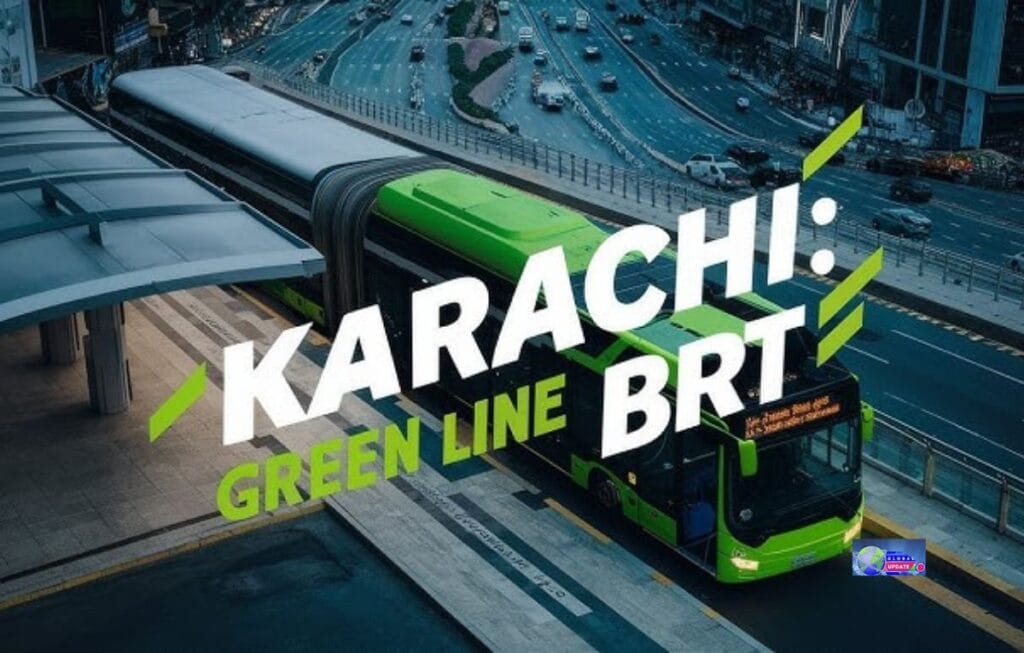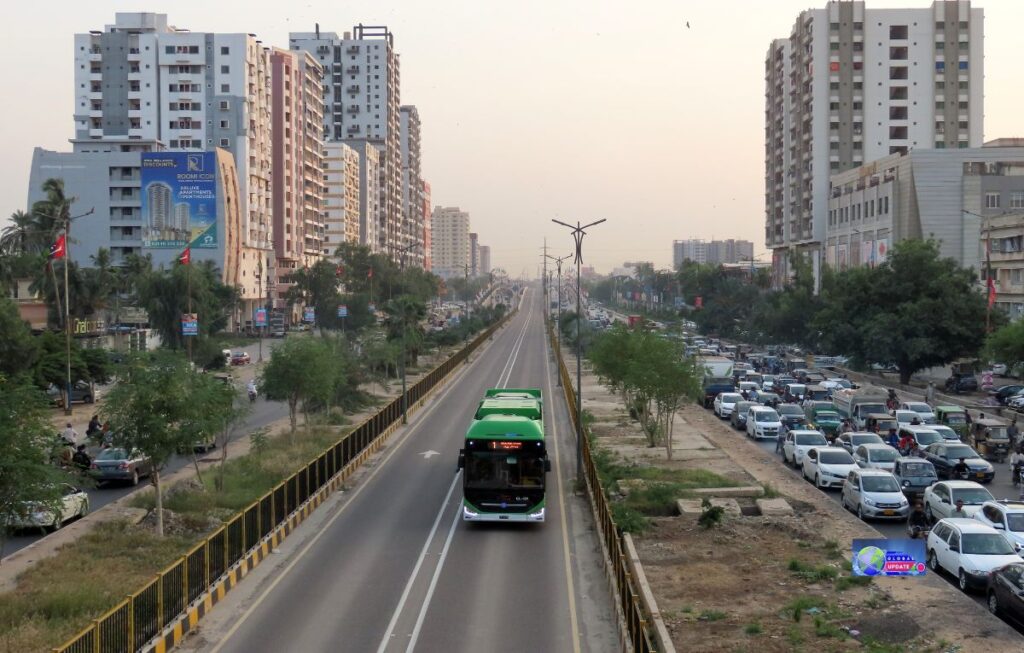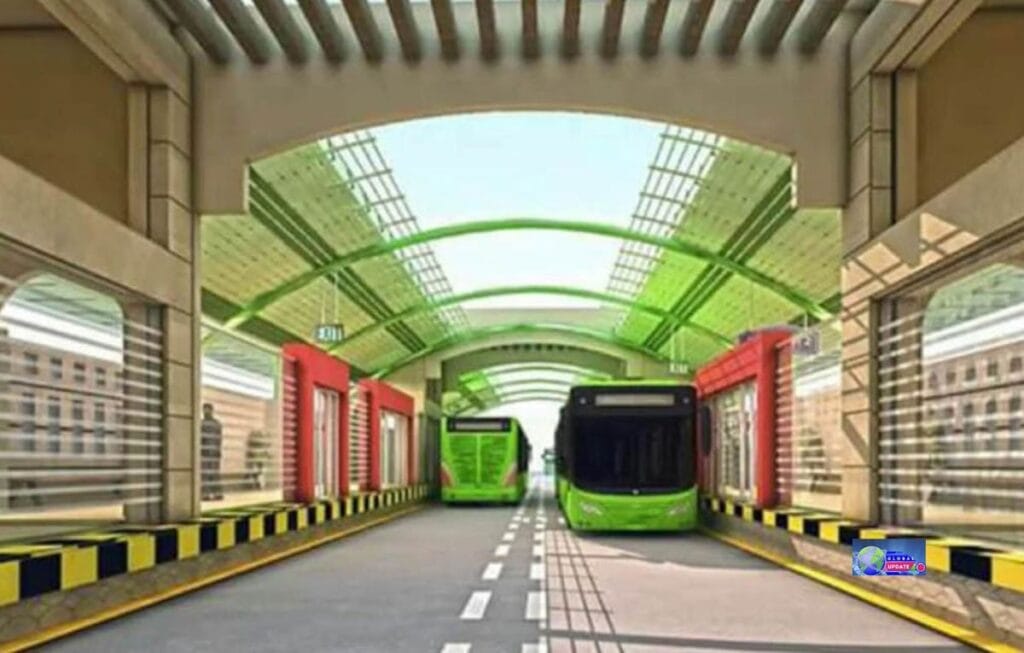The Green Line Bus Karachi is a modern rapid transit service designed to provide fast, affordable, and comfortable travel across the city.
The Green Line is Karachi’s first modern Bus Rapid Transit (BRT) corridor and a significant step toward organised mass transit in Pakistan’s largest city.
Former Prime Minister Imran Khan inaugurated the Green Line Bus Karachi project on December 10, 2021.

Launched in late 2021, the Green Line links residential suburbs in the northwest with central Karachi using a fully segregated busway—a dedicated fleet of modern buses and station-based boarding.
Below you’ll find an up-to-date, plagiarism-free guide covering the route, tickets and fares, history, technical features, and main stops—all with authoritative sources cited.
Quick facts (at a glance)
- Operational since December 2021, with commercial operation beginning in January 2022.
- Route length is approximately 18 to 21 kilometres, depending on the method of measurement; the first phase operates between Surjani/Surjani Terminal (Surjani Town) and Numaish/Numaish Chowrangi.
- The first phase includes 22 stations, with small extensions planned or currently in progress, as well as additional future phases.
- The fleet size will initially consist of 80 buses, which are hybrids and low-emission vehicles.
- The estimated daily ridership is expected to be in the tens of thousands, while early operations recorded hundreds of thousands of riders each month.
Brief history—how the Green Line came to be
The Green Line BRT project was initiated to establish a modern, dedicated public transport system in Karachi.
Construction began in 2016 under federal direction and faced periods of delay; the corridors, depots and dedicated bus fleet were completed and inaugurated in late 2021, with commercial service rolling out in early 2022.
The project was funded and implemented through federal and provincial coordination, and its cost was estimated in the multi-billion rupee range.
The development phase included the procurement of a new bus fleet consisting of 80 buses in phase I, as well as the construction of elevated and segregated busways and stations.
The Green Line also notable for its environmental ambitions: project documents and international partners highlight a low-emission fleet strategy (including hybrid/biomethane and future electric options) and integrated last-mile planning.
The Green Line project has linked global climate and development funds to improve the environmental sustainability of both the bus fleet and its fuel supply.
Route and major stops
Phase I forms an almost north-south corridor across western/central Karachi with roughly one station per kilometre. The exact station list has minor naming variations across publications, but core stops include
Surjani Terminal / Abdullah Chowk → 4K Chowrangi → North Karachi / UP Mor → Nagan Chowrangi → Sakhi Hassan → Hyderi → Shahrah-e-Jehangir area → North Nazimabad → Nazimabad (several numbered stops) → Numaish Chowrangi (terminus near central Sindh)—along the way serving busy commercial & residential hubs, malls and interchange points (e.g., near Guru Mandir area, Urdu Bazaar, and Gul Bahar).
(This is a representative list; please consult live route maps for the exact and up-to-date station names and their order.
Because the corridor links major residential areas (Surjani, North Nazimabad, and Nazimabad) with central commercial zones, it has become a vital commuter artery.
New minor extensions and phase 2 works have planned to improve the reach in Saddar and other central districts.

Tickets, fares, and how to ride
Ticketing model: The Green Line uses station-based ticketing with MetroCard/e-ticket options and single-journey tokens at stations.
Authorities and operators introduced a reloadable card/Breeze app ecosystem for balance top-ups, tracking and faster boarding—similar to other BRT systems worldwide.
Fare structure (typical): Fares have reported with a minimum of PKR 15 and a maximum of PKR 55 on the Green Line (single-trip), with subsidies periodically applied by the government to keep fares affordable.
In practice, many public pages and official updates indicate a fare range of Rs15 to Rs55, with a flat rate of Rs55 for certain journeys—check the latest notices because subsidy decisions and fare policies can change.
Practical tips for passengers
- Consider topping up a Breeze/Metro card (if available) to ensure faster entry and lower per-trip costs, especially if you are a regular commuter.
- Stations have security checks and controlled boarding—arrive a few minutes early during peak weekend rushes.
- Operational hours have varied in the early phases, but many reports indicate that typical service runs from early morning (around 6–7 am) to late evening (up to 10 pm); be sure to check daily schedules before traveling.
Key features & technical highlights
- The dedicated segregated busway runs on a lane that is separated from general traffic, ensuring faster and more predictable travel times compared to mixed traffic.
- Modern fleet: The initial fleet (approx. 80 buses) comprises hybrid or low-emission buses with high passenger capacity, designed for quick boarding and alighting at raised platforms. Some key highlights include charging ports, CCTV, disabled access, and comfortable interiors.
- Environmental orientation: Project documents and partner case studies highlight biomethane/hybrid technology and plans for biogas supply as a fuel, as well as future electrification or solar-assisted buses to reduce emissions. International climate funds supported the development of low-emission strategies during project planning.
- Station design & accessibility: Raised platforms, controlled entry/exit gates, and security checks help orderly boarding; stations designed for disabled access and platform-level boarding for quick flow.
- High frequency: At launch, authorities targeted frequent headways (multiple minutes between buses at peak). Early service reported very high passenger volumes, which required tight operational scheduling.
Impact so far—ridership & reception
The initial months saw strong demand, with more than a million passengers in the first month of commercial operation.
According to news reporting, many commuters welcomed the comfort, predictability and cost savings versus previous options.
However, like most new systems, the Green Line faced operational teething issues (maintenance, passenger crowd management and sustainability of subsidies).
Government plans and local authorities have continued to tweak operations and funding to keep fares reasonable.
Plans & expansions
Authorities have signalled phased expansions: short central extensions (e.g., into Saddar/Municipal Park) and feeder/electric buses for last-mile connectivity.
Some reports mention phase-two works and the induction of additional electric/solar buses for feeder routes to broaden the network and reduce emissions.
Monitor the official transport department updates for confirmed timelines.
Practical summary & commuter tips
- Best for: Regular commuters along the Surjani–Numaish corridor who want faster, safer and more predictable travel.
- Buy a Metro/Breeze card if you travel often—it reduces boarding time and can cheaper in the long run.
- Check fare notices before travel—fares and subsidy arrangements have changed at times, depending on government policy.



